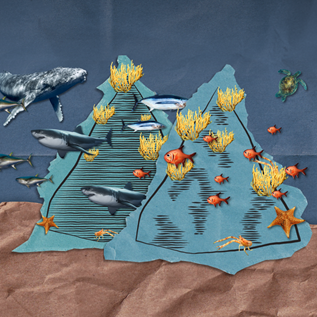Coral Reefs Prevent $4.3 Billion in Flood Damage Annually
Small loss of these natural barriers would more than double costs of flooding, study finds

Protecting the top 1 meter of nearshore, shallow-water coral reefs can save countries across the world $4.3 billion in annual flood protection benefits, according to a new study published in the journal Nature Communications. The research was led by Mike Beck, lead marine scientist at The Nature Conservancy, and supported by his 2012 Pew fellowship in marine conservation.
Healthy coral ecosystems regulate flooding and mitigate storm damages, providing natural protection for shorelines and adjacent areas. When corals are lost, the result is increased coastal flooding, which in turn incurs economic impacts on residents, communities, and government at all levels. Population growth, coastal development, and climate change are exacerbating the impacts of these losses.
The researchers compiled estimates of sea level and wave energy for all coastlines with coral reefs—approximately 71,000 kilometers (44,117 miles) globally. They then estimated likely flooding from storms—and the impacts of that on the land and built environment—under two scenarios: with and without the top 1 meter of reef. The authors chose 1 meter because it represents a loss of some to most of the living corals, but not the underlying limestone structure.
Reef loss would allow costlier and more widespread flooding
The study’s authors found that a decline of just 1 meter in reef height from present levels would more than double annual expected damages from storms, from $3.7 billion to $8 billion annually. The study also predicts an 81 percent increase in the land area affected by flooding annually, and a 69 percent rise in the number of people affected by flood damage each year.
“We’re in an era when we’re losing coastal habitats. And the risks to both those habitats and to people are increasing greatly,” says Beck (see video below). “The core goal of my Pew fellowship was to figure out if we could turn some of those threats into opportunities to invest in those habitats to protect people, property, and the ecosystems.”
The protections offered by healthy reefs were found to be greatest for lower intensity storms, which happen more frequently. However, the study estimates that coral reefs also provide substantial protection from more severe storms.
“It’s only in the past 10 to 15 years that we’ve recognized that these habitats provide really important services and benefits,” says Beck. “The coastal protection that they provide is by breaking waves and reducing storm surges and flooding.”
Coral protections offer most benefits in storm hotspots
The protections provided by coral reef habitats are distributed unevenly across the globe. Certain hotspots—areas subject to frequent storms, protected by shallow reefs, and with valuable assets near the coast—receive the greatest benefits from healthy reefs in terms of avoided losses of life and property.
The projected savings were greatest for Indonesia ($639 million); the Philippines ($590 million); Malaysia ($452 million); Mexico ($452 million); Cuba ($401 million); and the United States ($94 million)—a combined savings of more than $2.6 billion for those six countries.
For many smaller islands and developing states, although the dollar benefits are often less than $1 million each, they are much more important to the national economy. In particular, the Cayman Islands, Belize, Grenada, and the Bahamas receive the greatest benefits relative to their gross domestic products.
The results confirm the importance of nearshore shallow coral reefs in reducing flood damage, and reinforce the case for reducing local pressures on reefs, such as pollution, sedimentation, and destructive fishing.
Beck points out that, globally, enormous amounts of money are spent on recovery after coastal storms. “Reducing those risks, reducing those costs, makes good economic sense for everybody,” he says.
The economic benefits of protecting reefs could provide decision-makers with incentives to invest in habitat conservation and restoration. Climate change in particular will make reef restoration and management more necessary and valuable, as storm surges become stronger and more frequent.
Polita Glynn directs The Pew Charitable Trusts’ Pew Fellows Program in Marine Conservation.






